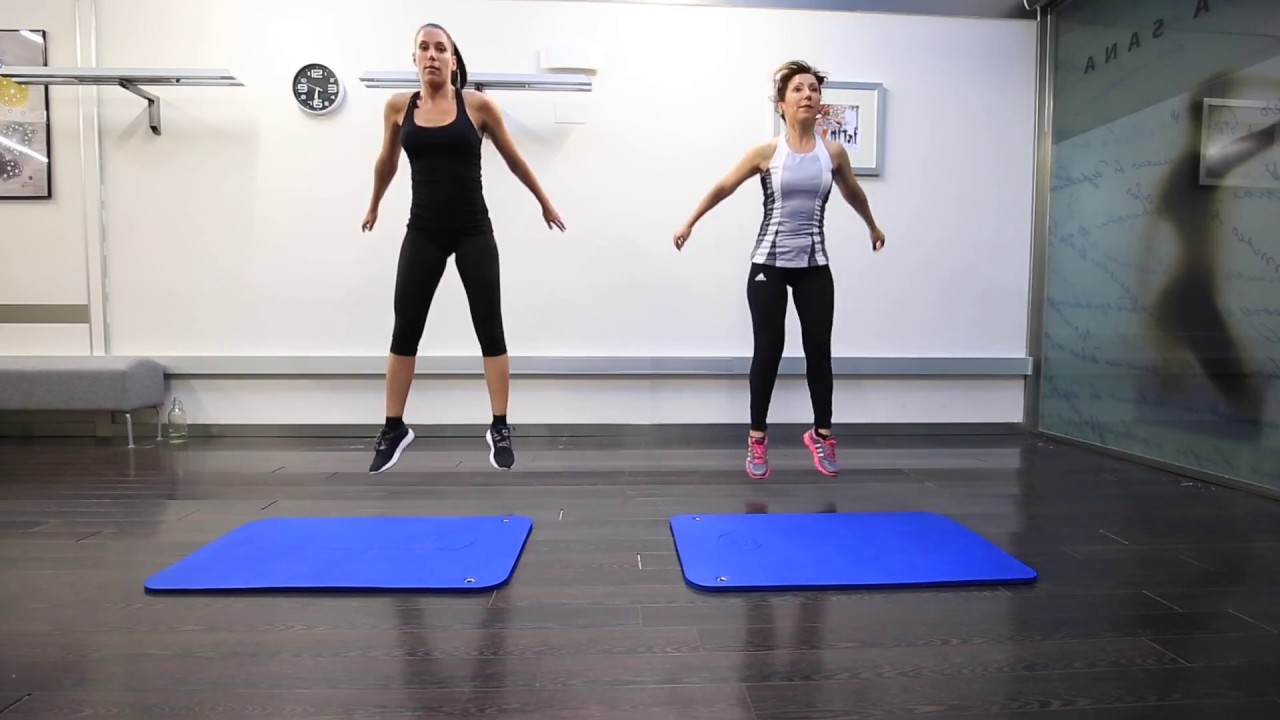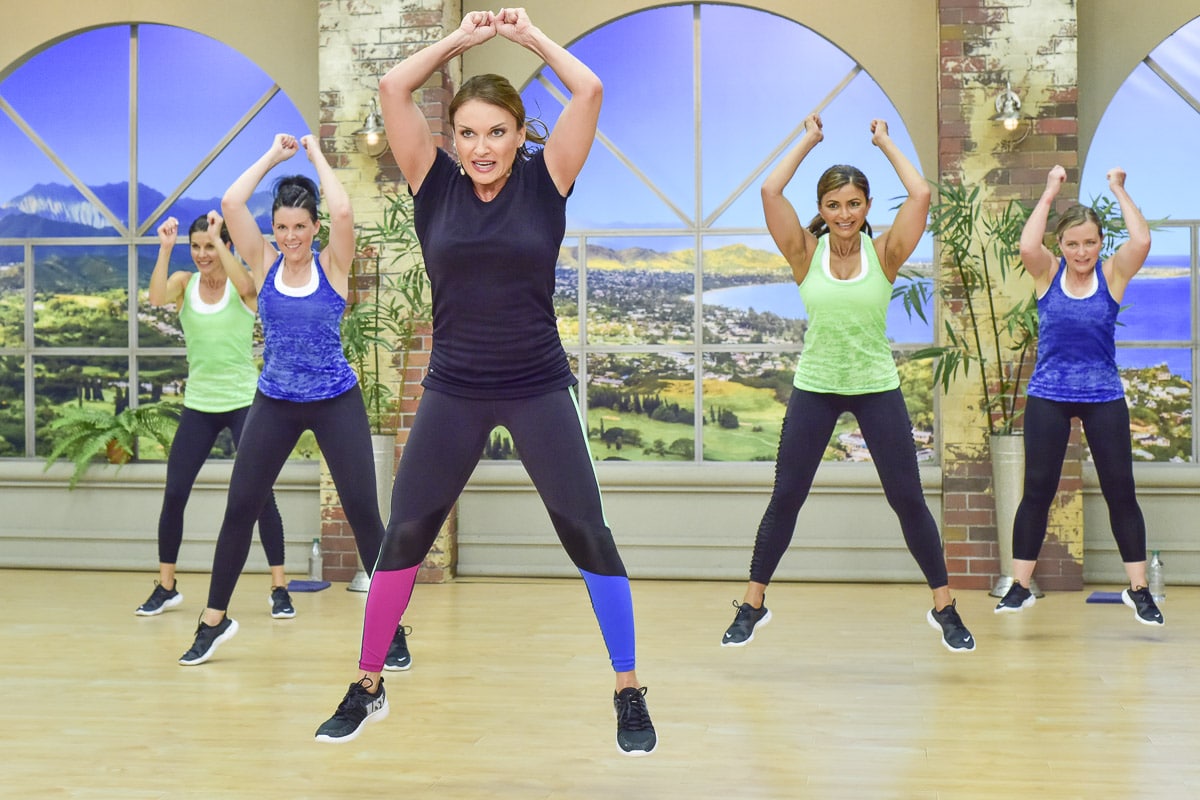Home>Misc>Featured>How Often Should You Do Tabata High Intensity Interval Training


Featured
How Often Should You Do Tabata High Intensity Interval Training
Modified: March 2, 2024
Learn how often you should incorporate high intensity interval training (HIIT) Tabata workouts into your fitness routine. Discover the benefits of this featured workout.
Introduction
Are you tired of spending hours at the gym without seeing the results you want? Look no further than High Intensity Interval Training (HIIT) Tabata workouts. This popular and effective training method has gained immense popularity in recent years for its ability to maximize results in a short amount of time.
High Intensity Interval Training (HIIT) is a training method that alternates between short, intense bursts of exercise and brief recovery periods. It pushes your body to its limits, demanding maximum effort and energy expenditure. The Tabata method, named after Japanese scientist Dr. Izumi Tabata, is a HIIT workout that follows a specific protocol of 20 seconds of intense exercise, followed by 10 seconds of rest, repeated for a total of 8 rounds. This intense and structured format of HIIT training allows you to achieve a high level of cardiovascular and muscular endurance in a short period of time.
The benefits of High Intensity Interval Training (HIIT) are numerous. It not only burns a significant amount of calories during the workout, but it also keeps your metabolism elevated for hours after the session, resulting in increased fat burning and improved overall fitness. HIIT Tabata workouts are also known to improve cardiovascular health, increase lean muscle mass, enhance endurance, and boost metabolism.
Before diving into HIIT Tabata workouts, it is essential to consider your current fitness level and any underlying health conditions. HIIT can be intense and physically demanding, so it’s important to consult with a healthcare professional before starting this type of training. Additionally, it is crucial to warm up properly and use proper form during exercises to prevent injuries.
Now that you understand the basics of HIIT Tabata workouts and its benefits, you might be wondering how often you should incorporate this training into your fitness routine. In the following sections, we will explore the factors to consider when determining the frequency of your HIIT Tabata workouts and provide a sample workout schedule to help you get started on your fitness journey.
What is High Intensity Interval Training (HIIT)?
High Intensity Interval Training (HIIT) is a form of exercise that involves short, intense bursts of activity followed by periods of rest or low-intensity exercise. It is a highly efficient and time-effective way to improve cardiovascular fitness, burn calories, and build strength.
The concept behind HIIT is to push your body to its limits during the high-intensity intervals, which can range from 20 seconds to a few minutes, followed by a short period of recovery. This intense training stimulates your cardiovascular system and muscles, leading to significant improvements in endurance and overall fitness.
What sets HIIT apart from traditional cardiovascular exercises is the intensity and variability of the workout. Rather than maintaining a steady-state pace, HIIT incorporates intervals of maximum effort followed by short periods of rest. This challenges your body to adapt and recover quickly, resulting in improved aerobic and anaerobic capacity.
HIIT workouts can take many forms, including running, cycling, rowing, bodyweight exercises, and even swimming. The key is to perform each exercise with maximum effort during the high-intensity intervals and allow your body to recover during the rest periods.
One of the major benefits of HIIT is its time efficiency. Due to the high intensity and shorter duration of the workout, you can achieve the same or even greater cardiovascular benefits compared to longer, steady-state exercises like jogging or cycling for extended periods of time. HIIT workouts can typically be completed in as little as 20-30 minutes, making them ideal for individuals with busy schedules.
Another advantage of HIIT is its ability to promote fat burning and increase metabolic rate. The intense effort during the high-intensity intervals increases the demand for energy, leading to a higher rate of calories burned both during and after the workout. This phenomenon, known as excess post-exercise oxygen consumption (EPOC), causes your body to burn more calories during the recovery period to restore your body to its pre-exercise state.
In addition to its cardiovascular benefits, HIIT has been shown to improve muscular strength and endurance. The explosive movements and resistance exercises incorporated into HIIT workouts engage multiple muscle groups, leading to increased muscle tone and strength development. This makes HIIT an excellent option for those looking to build lean muscle while also improving their cardiovascular fitness.
Overall, High Intensity Interval Training (HIIT) is an effective and time-efficient exercise method that can improve cardiovascular fitness, increase calorie burn, promote fat loss, and enhance muscular strength. Its versatility and adaptability make it suitable for individuals of all fitness levels, and it can easily be incorporated into any fitness routine.
Understanding the Tabata Method
The Tabata Method, named after Japanese scientist Dr. Izumi Tabata, is a specific form of High Intensity Interval Training (HIIT) that follows a unique protocol. Developed in the 1990s, this training method has gained popularity for its effectiveness in improving both aerobic and anaerobic fitness.
The Tabata Method consists of 20 seconds of intense exercise followed by 10 seconds of rest, repeated for a total of 8 rounds. This pattern of work and rest is performed for a total of four minutes. Within this short timeframe, the high-intensity intervals push your body to its limits, while the brief rest periods allow for some recovery before the next intense burst.
The key to the Tabata Method’s effectiveness lies in its ability to increase your heart rate significantly during the intense intervals. This elevated heart rate creates a cardiorespiratory response, improving your cardiovascular fitness. Additionally, the high-intensity nature of the exercise stimulates your muscles and prompts an increase in anaerobic capacity.
The Tabata Method can be performed with a variety of exercises, making it versatile and adaptable to individual preferences and fitness goals. Common exercises used in Tabata workouts include squats, burpees, jumping jacks, push-ups, and sprints. The idea is to choose exercises that engage large muscle groups and can be performed with maximum effort during the 20-second intervals.
It’s important to note that the Tabata Method is intended to be challenging and intense. The short duration and high intensity make it suitable for individuals who are looking for a quick and effective workout. However, it may not be suitable for beginners or individuals with certain health conditions. It is always recommended to consult with a healthcare professional before starting any new exercise program.
When incorporating the Tabata Method into your fitness routine, it is essential to prioritize proper form and technique. While the intervals are short, it’s crucial to maintain good form to prevent injuries. If you’re new to Tabata or HIIT workouts, start with lower-intensity exercises and gradually increase the intensity as your fitness level improves.
In summary, the Tabata Method is a specific protocol of High Intensity Interval Training that utilizes 20 seconds of intense exercise followed by 10 seconds of rest, repeated for a total of 8 rounds. It is an effective and efficient way to improve cardiovascular fitness and increase anaerobic capacity. By incorporating the Tabata Method into your fitness routine and selecting exercises suited to your preferences and goals, you can experience the benefits of this high-intensity training method. Just remember to always listen to your body and consult with a professional before starting any new exercise program.
Benefits of High Intensity Interval Training (HIIT)
High Intensity Interval Training (HIIT) has gained immense popularity in the fitness world, and for good reason. This form of training offers a multitude of benefits that can help you achieve your fitness goals more efficiently and effectively. Let’s explore some of the key benefits of incorporating HIIT into your workout routine.
1. Increased Calorie Burn: HIIT workouts are incredibly effective at burning calories. The high-intensity intervals push your body to its limits, causing an increase in heart rate and energy expenditure. This leads to a significant calorie burn during and after the workout. In fact, studies have shown that HIIT can burn more calories in a shorter amount of time compared to steady-state cardio exercises.
2. Improved Cardiovascular Fitness: HIIT is a fantastic way to improve your cardiovascular health. The intense intervals push your heart rate to higher levels, effectively improving your aerobic capacity. Over time, this can lead to better endurance, increased stamina, and improved overall cardiovascular fitness.
3. Time Efficiency: One of the major advantages of HIIT is its time efficiency. With HIIT, you can achieve a great workout in a shorter amount of time compared to traditional steady-state cardio exercises. HIIT workouts typically range from 15 to 30 minutes, making it perfect for individuals with busy schedules or those looking to maximize their workout efficiency.
4. Increased Fat Burning: HIIT workouts not only burn calories during the session but also have a lasting effect on fat burning. The high-intensity intervals create an “afterburn” effect, known as excess post-exercise oxygen consumption (EPOC). This means that your body continues to burn calories and fat at an increased rate even after the workout is over. HIIT has been shown to significantly increase metabolic rate, leading to enhanced fat loss.
5. Preservation of Lean Muscle Mass: Unlike traditional cardio exercises, which can result in muscle loss over time, HIIT has been shown to help preserve lean muscle mass. The intense bursts of exercise paired with short recovery periods promote muscle growth and strength development. This is particularly beneficial for individuals looking to improve their body composition and achieve a toned physique.
6. Versatility and Variety: HIIT workouts can be tailored to suit individual preferences and fitness levels. There is a wide range of exercises and variations that can be incorporated into HIIT workouts, making them versatile and adaptable. This variety helps to keep workouts interesting and engaging, preventing boredom and plateaus.
Incorporating HIIT into your workout routine can offer numerous benefits, including increased calorie burn, improved cardiovascular fitness, time efficiency, enhanced fat burning, preservation of lean muscle mass, and versatility. Whether your goal is to lose weight, improve endurance, or build strength, HIIT can be a valuable addition to your fitness regimen. Remember to start at a level that is appropriate for your fitness level and gradually progress to more intense workouts over time.
Considerations before Starting HIIT Tabata Workouts
Before diving into HIIT Tabata workouts, there are several important considerations to keep in mind. While this form of training can be highly effective, it is not suitable for everyone. Understanding these considerations will help ensure that you approach HIIT Tabata workouts safely and get the most out of your training.
1. Fitness Level: HIIT Tabata workouts are intense and physically demanding. It’s important to assess your current fitness level before starting this type of training. If you’re new to exercise or have been inactive for a while, it may be beneficial to build a foundation of cardiovascular fitness and muscular strength through lower-intensity workouts before attempting HIIT Tabata workouts.
2. Health Conditions: While HIIT can offer numerous benefits, it may not be appropriate for individuals with certain health conditions or injuries. If you have any pre-existing health conditions, such as cardiovascular problems, orthopedic issues, or respiratory concerns, it is crucial to consult with a healthcare professional before starting HIIT. They can evaluate your individual circumstances and provide guidance on whether HIIT Tabata workouts are safe for you.
3. Warm-up and Cool-down: Due to the high intensity of HIIT Tabata workouts, it is essential to properly warm up before starting. This helps prepare your muscles, joints, and cardiovascular system for the intense exercise ahead. Incorporate dynamic stretches, mobility exercises, and a gradual increase in intensity to warm up your body. Similarly, after completing the workout, take time for a proper cool-down, including static stretches and deep breathing, to aid in recovery and prevent muscle soreness.
4. Proper Form and Technique: Ensuring proper form and technique is vital during HIIT Tabata workouts to prevent injuries. Focus on maintaining proper alignment, engage your core, and use controlled movements throughout the exercises. If you’re unsure about proper form, consider working with a qualified fitness professional who can guide you and provide feedback to help you perform the exercises correctly.
5. Gradual Progression: HIIT Tabata workouts can be physically demanding, even for individuals who are accustomed to regular exercise. It’s crucial to progress gradually as you increase the intensity and duration of your workouts. Start with a shorter duration and lower intensity and gradually build up over time. Listen to your body and give yourself adequate rest and recovery days to prevent overtraining and potential injuries.
6. Individualization: Every individual is different, and what works for one person may not work for another. Tailor your HIIT Tabata workouts to your individual needs and preferences. Choose exercises that you enjoy and that are suitable for your fitness level. Modify or substitute exercises as necessary to accommodate any limitations or restrictions you may have.
By considering these important factors, you can approach HIIT Tabata workouts safely and effectively. Always prioritize your safety and listen to your body. Starting slowly and gradually progressing will help you achieve long-term success and minimize the risk of injury. Consult with a healthcare professional or fitness expert if you have any concerns or questions about incorporating HIIT Tabata workouts into your fitness routine.
How Often Should You Do HIIT Tabata Training?
Determining the frequency of HIIT Tabata training depends on various factors, including your fitness level, goals, recovery ability, and overall schedule. While HIIT Tabata workouts can be highly effective, they also place significant stress on your body. Finding the right balance is crucial to avoid overtraining and maximize the benefits of your training.
For beginners or those new to HIIT, it’s generally recommended to start with 1-2 HIIT Tabata workouts per week. This allows your body to adapt to the high-intensity nature of these workouts and recover adequately between sessions. As you become more accustomed to the intensity, you can gradually increase the frequency if desired.
For intermediate and advanced individuals with a higher fitness level, 2-4 HIIT Tabata workouts per week may be appropriate. However, it’s important to listen to your body and monitor how you’re recovering between workouts. If you’re constantly sore, experiencing decreased performance, or feeling excessively fatigued, it may be a sign that you need more rest and recovery.
Another consideration is the balance between HIIT Tabata training and other forms of exercise. It’s important to incorporate a variety of exercises into your routine, including strength training, flexibility work, and low-intensity cardio. This helps prevent muscle imbalances, reduces the risk of injuries, and ensures overall fitness and well-being.
Ultimately, the frequency of HIIT Tabata training should align with your goals and lifestyle. If your primary focus is fat loss and improving cardiovascular fitness, 2-4 HIIT Tabata workouts per week, combined with other forms of exercise, can yield great results. However, if you’re aiming for muscle building or increasing strength, you may need to adjust the frequency to allow for adequate recovery and prioritize other forms of training.
Remember, recovery is just as important as the workouts themselves. Rest days are essential to give your body time to repair and rebuild. Listen to your body, pay attention to any signs of excessive fatigue or lack of progress, and adjust the frequency of your HIIT Tabata workouts accordingly.
When determining the frequency of HIIT Tabata training, consider factors such as your fitness level, goals, recovery ability, and overall schedule. Start with 1-2 workouts per week and gradually increase as you become more accustomed to the intensity. Find the right balance and incorporate other forms of exercise to ensure overall fitness and prevent overtraining. By personalizing your approach, you can optimize the benefits of HIIT Tabata training and achieve the results you desire.
Factors to Consider when Determining Frequency of HIIT Tabata Workouts
Finding the optimal frequency of HIIT Tabata workouts depends on several factors. While there is no one-size-fits-all answer, considering these key factors will help you determine the right frequency for your individual circumstances and goals.
1. Fitness Level: Your current fitness level plays a significant role in determining the frequency of HIIT Tabata workouts. If you’re new to exercise or have a low fitness level, it’s important to start with a lower frequency, such as 1-2 workouts per week, to allow your body time to adapt and recover. As your fitness level improves, you can gradually increase the frequency if desired.
2. Recovery Ability: Recovery is essential for progress and avoiding overtraining. Some individuals have a higher recovery ability and can handle more frequent HIIT Tabata workouts, while others may need more time to recover between sessions. Pay attention to how your body responds to the intensity of the workouts and adjust the frequency accordingly. Signs of insufficient recovery include excessive fatigue, decreased performance, loss of motivation, and increased risk of injuries.
3. Goals: Your specific fitness goals will also influence the frequency of HIIT Tabata workouts. If you’re primarily focused on fat loss and improving cardiovascular fitness, you may benefit from more frequent HIIT Tabata sessions (2-4 workouts per week). On the other hand, if your goals are centered around muscle building or strength gains, you may need to reduce the frequency to prioritize other forms of training and allow for ample recovery.
4. Other Forms of Exercise: Consider the other forms of exercise you incorporate into your routine. It’s important to have a well-rounded fitness program that includes strength training, flexibility work, and low-intensity cardio. If you’re already engaging in other intense workouts or strength training sessions, you may need to adjust the frequency of your HIIT Tabata workouts to avoid overexertion and ensure proper recovery.
5. Schedule and Lifestyle: Your schedule and lifestyle play a practical role in determining the frequency of HIIT Tabata workouts. Evaluate your weekly commitments and consider how many sessions you can realistically fit into your schedule. It’s better to have a consistent and sustainable workout routine rather than overwhelming yourself with too many sessions that are difficult to maintain over time.
Remember, there is no one-size-fits-all answer when it comes to the frequency of HIIT Tabata workouts. Personalization is key. Start with a conservative frequency, such as 1-2 workouts per week, and gradually increase as your fitness level and recovery ability improve. Listen to your body, monitor how you’re recovering between workouts, and adjust the frequency accordingly. By considering these factors, you can optimize the benefits and results of your HIIT Tabata training while maintaining a balanced and sustainable fitness routine.
Sample HIIT Tabata Workout Schedule
Having a structured workout schedule is essential to stay consistent and make progress with your HIIT Tabata training. Here’s a sample schedule that can serve as a guideline for planning your weekly workouts.
Day 1: Total Body HIIT Tabata Workout
On the first day of your HIIT Tabata training, focus on a total body workout. Choose exercises that target multiple muscle groups and involve both cardiovascular and strength components. For example, your workout could include exercises like burpees, squat jumps, mountain climbers, push-ups, and bicycle crunches. Perform each exercise for 20 seconds, followed by 10 seconds of rest, and repeat for a total of 8 rounds.
Day 2: Active Recovery
On the second day, engage in active recovery to allow your body to recover from the intensity of the previous day’s workout. Opt for low-impact exercises such as walking, swimming, or gentle stretching. The goal is to keep your body moving without exerting too much effort.
Day 3: Lower Body HIIT Tabata Workout
Focus on your lower body with a HIIT Tabata workout that targets the legs, glutes, and lower body muscles. Incorporate exercises such as jump squats, lunges, kettlebell swings, and high knees. Perform each exercise for 20 seconds, rest for 10 seconds, and repeat for 8 rounds.
Day 4: Rest or Active Recovery
Take a day off to allow your body to rest and recover. Alternatively, engage in light active recovery exercises like yoga or stretching to promote blood flow and flexibility.
Day 5: Upper Body HIIT Tabata Workout
Shift the focus to your upper body with a HIIT Tabata workout that targets the arms, chest, and back muscles. Include exercises like push-ups, tricep dips, mountain climbers, and plank jacks. Follow the 20 seconds of exercise and 10 seconds of rest format for 8 rounds.
Day 6: Full Body HIIT Tabata Workout
Engage in a full-body HIIT Tabata workout that combines exercises from each muscle group for a comprehensive session. Include a mix of cardiovascular and strength exercises like burpees, jumping jacks, kettlebell swings, and planks. Perform each exercise for 20 seconds with 10 seconds of rest, repeating for a total of 8 rounds.
Day 7: Rest or Active Recovery
Take another day off for rest or engage in light active recovery activities to promote mobility and flexibility.
This sample HIIT Tabata workout schedule provides a balanced routine that targets different muscle groups and allows for adequate rest and recovery. However, feel free to adjust the schedule according to your preferences, fitness level, and goals. Remember to warm up before each workout and cool down afterward, and always listen to your body to prevent overtraining and injuries.
Conclusion
High Intensity Interval Training (HIIT) Tabata workouts offer a time-efficient and effective way to improve cardiovascular fitness, burn calories, and build strength. By incorporating short bursts of intense exercise followed by brief recovery periods, HIIT Tabata workouts maximize results in a shorter amount of time compared to traditional cardio exercises. However, before starting HIIT Tabata workouts, it’s crucial to consider important factors such as your fitness level, health conditions, and recovery ability.
Starting with a conservative frequency, such as 1-2 workouts per week, allows your body time to adapt and recover. As you progress, you can gradually increase the frequency to 2-4 workouts per week, depending on your goals and recovery ability. It’s important to listen to your body and adjust the frequency accordingly to avoid overtraining and maximize the benefits of HIIT Tabata training.
The key to success with HIIT Tabata workouts is finding balance and incorporating them into a well-rounded fitness routine that includes strength training, flexibility work, and low-intensity cardio. This ensures overall fitness, prevents muscle imbalances, and reduces the risk of injuries.
In conclusion, HIIT Tabata workouts offer numerous benefits, including increased calorie burn, improved cardiovascular fitness, time efficiency, enhanced fat burning, preservation of lean muscle mass, and versatility. By considering your individual needs, goals, and recovery ability, you can determine the optimal frequency of HIIT Tabata workouts. Remember to prioritize proper form, warm up properly, and listen to your body to achieve long-term success and enjoy the benefits of this high-intensity training method. Get ready to push your limits, have fun, and achieve your fitness goals with HIIT Tabata workouts.









